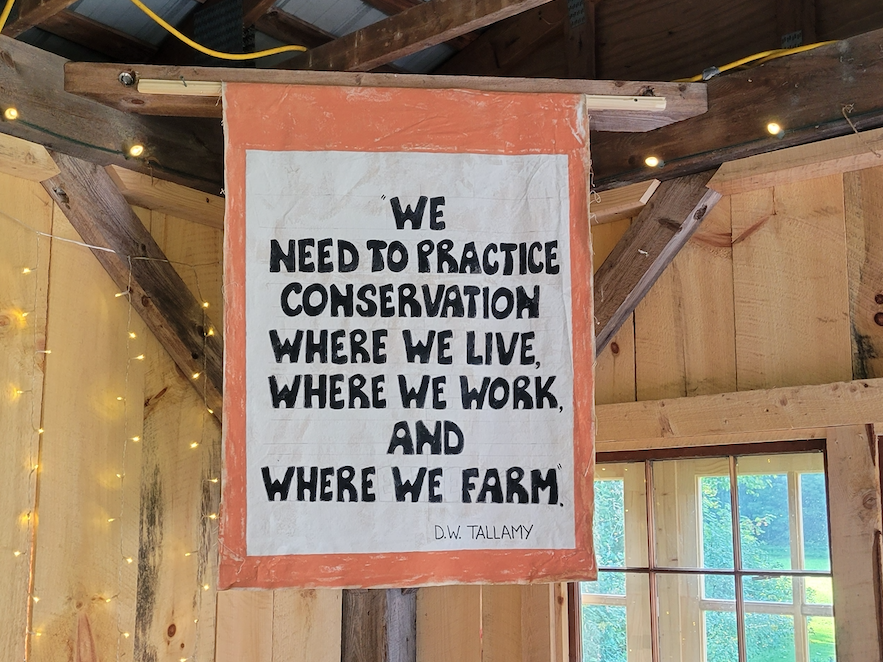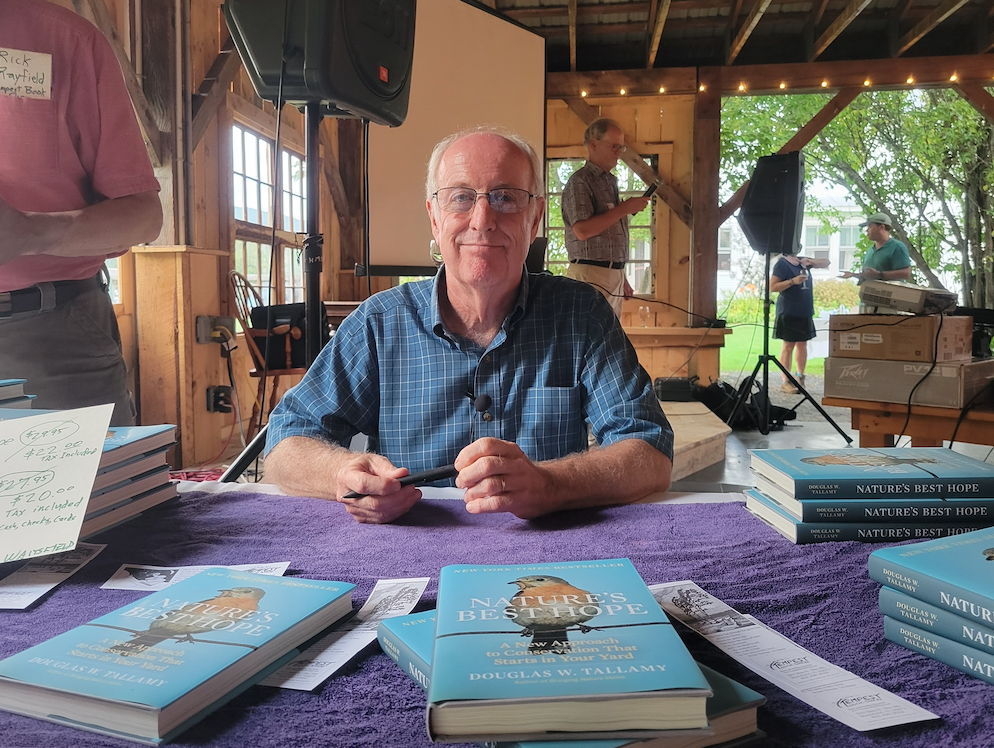VNRC and the Vermont Alliance for Half-Earth were proud to host renowned ecologist, Doug Tallamy, on August 26, at American Flatbread in Waitsfield, for an evening dedicated to growing a Homegrown National Park. View the recording here.
Tallamy, a professor of Agriculture and Natural Resources at the University of Delaware, and author of New York Times bestseller, Nature’s Best Hope, spoke about what it would take to reduce humanity’s impact on the intricate webs of plants, animals, and insects that sustain life on earth.
The world has lost ⅔ of its biodiversity since 1970. Such is the sobering reality that Tallamy used to frame our current predicament. We often think of biodiversity in more personal terms: the great variety of plants, animals, insects, fungi, and microorganisms that keep our environment healthy. The more the merrier, and the more connected the better. These webs of life provide the food, water filtration, pollination, and other ecosystem services that humans and wildlife need to thrive.
Here in Vermont, one of the primary threats to wildlife habitat is the increasing fragmentation of our forests. US Forest Service data shows that Vermont lost over 102,000 acres of forest from 2012 to 2017 (discussed on page 2 of our January 2019 VER), a trend that is being exacerbated by land subdivision, and the associated construction of roads and utility lines into once forested areas.
Another culprit across the US: lawns. These classic 20th century suburban status symbols are largely monocultures—ecological deserts consisting of one, or just a few species—that don’t provide the sustenance needed to sustain functioning ecosystems.
While the resulting precipitous decline in biodiversity is rightfully alarming, there is still time to turn these trends around, and each of us can play a vital role in this ecological restoration. Even small populations of insects and animals can recover, if given the right food sources, shelter, and sufficient time. These small recoveries can then go on to support larger ones.
Tallamy has a bold and timely proposal to transform enough land so these decimated populations that are so necessary to our ecological communities can recover. He calls his approach the Homegrown National Park. With over 40 million acres of U.S. land currently devoted to lawns (the size of New England), transforming just half of this area to wildlife habitat would be the equivalent of creating a new national park—greater than the total of most of the national parks in the lower 48 states combined! This is the approach outlined in Tallamy’s book, Nature’s Best Hope.

Whether you have acres to work with, or a few container plantings, how you use this space can be part of bringing back ecological diversity to our landscape. Tallamy stressed the important role of native plants, ones that have evolved over millennia in conjunction with pollinators and insects that are often specifically adapted to one single type of plant. Many of these insects are caterpillars, which are vital food sources for birds, especially when feeding their young (birdseed only goes so far!) So the next time you go to plant something, refer to the National Wildlife Foundation’s Native Plant Finder, where you can put in your zip code to find the plants that will support wildlife in your region. If you are shopping at a nursery, specifically ask for native varieties.
A few plants to start with: May apple, foamflower, native ferns, and wild ginger. Even better if you plant these under a keystone species, like oaks or sugar maples, which serve as the backbones of our ecosystem by supporting hundreds of species at some point in their lifecycles. For example, over 400 species of moths and butterflies rely on oaks as a host for their caterpillars, according to the Native Plant Finder. And once you’ve established your wildlife habitat, don’t forget to have it certified through NWF’s Certified Wildlife Habitat Program.
Another tip Tallamy shared was to switch your outdoor lights to yellow bulbs, and put them on a sensor. Light pollution at night is a major detriment to insect life, which serves as a primary food source for birds, reptiles, and amphibians, which play their own vital roles in our ecosystem.
Beyond these necessary individual actions, VNRC is working to advance policies that help protect our intact forests here in Vermont. This fall, we will be publishing updates to two important guides for town and regional planners: Community Strategies for Vermont’s Forests and Wildlife, and Wildlife Considerations in Local Planning. We are also monitoring parcelization trends through an interactive tool, that we can use to better inform state policy and land management solutions going forward.
Through a combined strategy of reconverting lawns back into whole ecosystems, and protecting the intact ecosystems we still have, we can support the wildlife that is necessary and intrinsic to a healthy environment. We appreciate Doug Tallamy sharing his insights, and along with the Vermont Alliance for Half Earth, are committed to preserving half our lands for wildlife—from half of our yards, to half of our towns, to half of our state and beyond. Humans thrive in abundant environments replete with other lifeforms—indeed our survival depends on them. As Tallamy summed up: Half is a starting point, not a final goal.
(View VNRC’s webinar on creating your own backyard wildlife habitat here.)
Resources
Online:
—National Wildlife Federation (NWF) Native Plant Finder: https://www.nwf.org/nativeplantfinder/
—Native Plant Trust: https://gobotany.nativeplanttrust.org/
—VT State Park’s resource on native ferns: https://vtstateparks.com/assets/pdf/ferns.pdf
—VT Invasives: https://vtinvasives.org/
—VT Dept. of Fish & Wildlife – VT Conservation Design: https://vtfishandwildlife.com/conserve/vermont-conservation-design
—Ethan Tapper, Chittenden County Forester: https://www.youtube.com/channel/UCG5pCDPHUyOiA2vW1l7L6oA
Publications:
—Steve Parren’s Backyard Wildlife Habitat in Vermont: tinyurl.com/backyard-wildlifehabitat
—Art Gilman’s New Flora of Vermont: https://vtecostudies.org/blog/comprehensive-new-book-published-on-vermonts-plants/
—VT Fish & Wildlife Department: Wetland, Woodland, Wildland: https://vtfishandwildlife.com/wetland-woodland-wildland
—VNRC’s latest VER, Vermont’s Backyard Biodiversity: https://vnrc.org/wp-content/uploads/2021/08/VER-2021-Issue-2.pdf
Regional Native Plant Sources:
—VT Wetland Plant Supply, Orwell, VT (wholesale): https://www.vermontwetlandplants.com/index/about-vwps/
—Intervale Conservation Nursery: https://www.intervale.org/intervale-conservation-nursery
—Northeast Pollinator Plants: https://www.northeastpollinator.com/
—Bagley Pond Perennials: https://bagleypondperennials.com/
—Wild Seed Project: https://shop.wildseedproject.net/
—Izel Native Plants (plugs for large plantings): https://www.izelplants.com/




